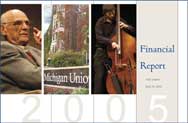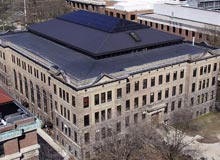

The University of Michigan Hospitals and Health Centers (UMHHC) received the 2005 Environmental Leadership Award—recognizing environmental innovation in health care—for its work in reducing waste, virtually eliminating mercury, and minimizing the use of toxic products.
UMHHC was one of five Michigan hospitals and eight national facilities to win the award given by Hospitals for a Healthy Environment, an organization that helps health care facilities enhance their workplace safety, reduce waste and disposal costs, and become better environmental stewards.
The UMHHC, working with its interior design group, set a purchasing standard for healthy products, including recycled content-containing and environmentally preferable carpets, wall coverings, paper, and wastebaskets. A chemical tracking system also identifies opportunities for chemical sharing, which reduces hazardous waste.
In addition, the UMHHC donation program grew in 2004 to include furniture, medical supplies, cell phones, mattresses, and eyeglasses. The comprehensive recycling program captured 934.5 tons of paper in 2004, and the M-Bay website allows staff to post furniture, equipment, and supplies to “swap“ within the institution, which serves as a model for similar programs across the country.
“These hospitals are leading the national movement for sustainable health care,” said Laura Brannen, director of Hospitals for a Healthy Environment. “They are setting the example for others to follow.”
 The School of Natural Resources and Environment (SNRE) received a gold LEED (Leadership in Energy and Environmental Design) rating from the U.S. Green Building Council for renovation of the Samuel T. Dana Building. This is the first major academic renovation to receive such a high rating in the state of Michigan and among the first in the country.
The School of Natural Resources and Environment (SNRE) received a gold LEED (Leadership in Energy and Environmental Design) rating from the U.S. Green Building Council for renovation of the Samuel T. Dana Building. This is the first major academic renovation to receive such a high rating in the state of Michigan and among the first in the country.
“Our building allows us to live what we teach: sustainability,” said Rosina Bierbaum, SNRE dean. “The building is a living, learning center and is a unique example that serves as a model for environmental sensitivity, education, and awareness that clearly demonstrates the effectiveness of green building principles.”
Materials normally discarded during refurbishing (bricks, attic timbers, and old windows and doors) were reused throughout the building, thus diverting material from landfills. Beautiful southern yellow pine attic timbers were made into conference tables and wood trim. Rubber flooring made from recycled rubber, ceiling panels made from biocomposites, bathroom tiles made from recycled glass, and toilet partitions made from recycled plastic bottles helped to transform the renovation project into a unique, sustainable building design laboratory.
Among the renovations that contributed to the LEED gold rating were: a 31-percent reduction in water use through installation of low-flow plumbing fixtures, composting toilets, and waterless urinals; a 30-percent reduction in energy use through installation of high-efficiency lighting and one of the first installations of ceiling-mounted radiant cooling systems in the U.S.; and retention of the historic 1903 structure and shell, plus more than half of the original interior elements, while upgrading the building to create a state-of-the-art educational environment.